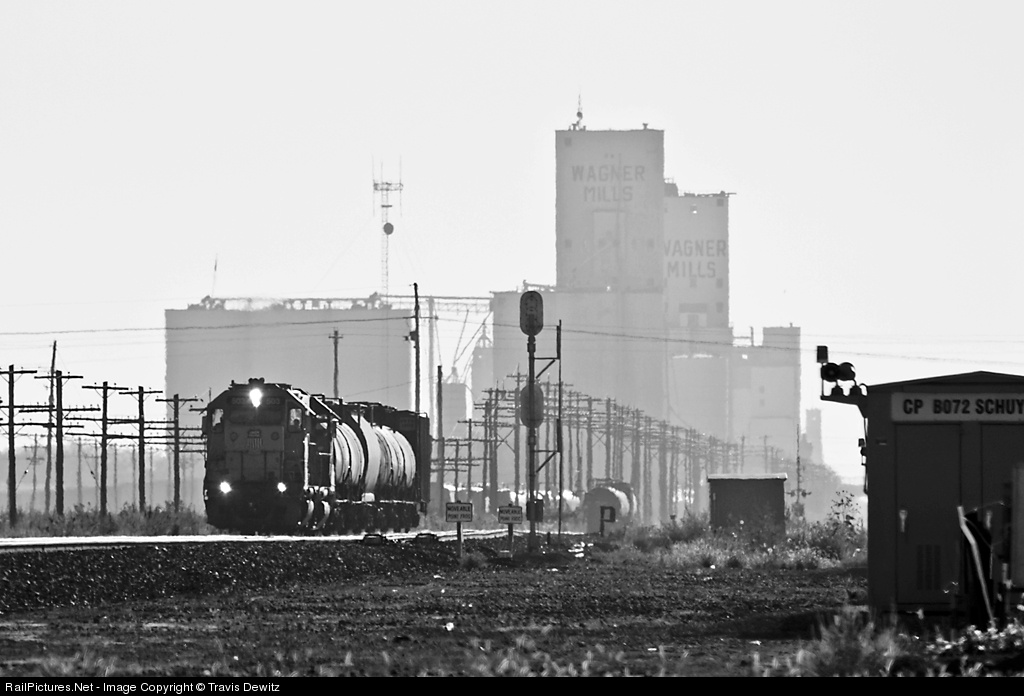 We all have seen lots and lots of images where the train is strongly backlit or in silhouette. Generally, these images contrast a dramatic dawn/dusk sky with lots of great color against the black of the train. Compositionally they are often somewhat simple: a wedge of a train against a simple background, sky with maybe a treeline or distant mountain ridge, with some interesting clouds.
We all have seen lots and lots of images where the train is strongly backlit or in silhouette. Generally, these images contrast a dramatic dawn/dusk sky with lots of great color against the black of the train. Compositionally they are often somewhat simple: a wedge of a train against a simple background, sky with maybe a treeline or distant mountain ridge, with some interesting clouds.What has caught my interest is the possibility for a different sort of background, one that is more of a secondary element or even co-main subject, to support the subject. Thus, the subject, being backlit/silhouetted, may have some detail or only provide a shape, but the background provides a secondary element which contrasts not only in light but in having interesting detail.
Consider the shot above by Peter Lerro (captioned version here). It is a classic backlit image. But look at the background, what an interesting hillside! Not only the several structures, but also the line of the valley and the splash of light on the field between the engine and barn. The barn complements the train and itself is a combination of darker and lighter elements. The background livens things up. (As does the presence of detail on the visible dark side of the train.) The shot does not tend toward the abstract nearly as much as silhouette shots do.
 I like the shot - very much - but it only pushes part of the way toward the sort of image I am thinking of. So consider this shot by Travis Dewitz (captioned version here). The background is strong with the grain elevator (but gets a bit muddled with what Travis calls a "utility mess"). But the train is small and is not backlit but rather sidelit, and thus does not have the dramatic separation from the background that attracts me to these types of shots (and I find the presence of the shack at the right too strong and also uninteresting).
I like the shot - very much - but it only pushes part of the way toward the sort of image I am thinking of. So consider this shot by Travis Dewitz (captioned version here). The background is strong with the grain elevator (but gets a bit muddled with what Travis calls a "utility mess"). But the train is small and is not backlit but rather sidelit, and thus does not have the dramatic separation from the background that attracts me to these types of shots (and I find the presence of the shack at the right too strong and also uninteresting). What I love is this shot, part of the gold medal-winning portfolio submitted by Olaf Haensch for the 2008 CRPA competition. The engine is in full silhouette but has interesting edge detail. The background is well lit for a night shot and has impressive texture and details and just a touch of color. Putting a steaming train in front of it in a daylight shot would be just fine but the contrast offered by the dark train (and dark sky) makes the building leap out. The contrast also increases the sense of depth, as I suspect that a daylight shot would not have the same strong feel of separation between the train in front and the building behind.
What I love is this shot, part of the gold medal-winning portfolio submitted by Olaf Haensch for the 2008 CRPA competition. The engine is in full silhouette but has interesting edge detail. The background is well lit for a night shot and has impressive texture and details and just a touch of color. Putting a steaming train in front of it in a daylight shot would be just fine but the contrast offered by the dark train (and dark sky) makes the building leap out. The contrast also increases the sense of depth, as I suspect that a daylight shot would not have the same strong feel of separation between the train in front and the building behind.Great details pervade the scene: the (lancet?) arches of the windows and doors, the two tones in the plume, the puddle reflections. But those are specifics, combining into an overall effect which conveys a strong sense of fine beauty, of the angel in the details. Click on it, take a look at a larger version, very well done!








